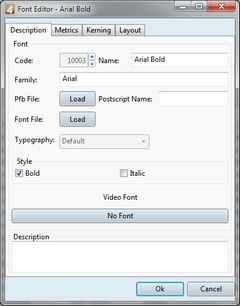GN4 font properties, are read from the font itself, during the installing in GN4. Please note that some properties may need adjustments.

Description tab contains general data about the font.
The code you need to specify during import. Should be in the range of 1 to 32767. Must be unique.
|
The name is typically the original font name. There are no restrictions about spaces in name.
|
The string with the font family name is used by the GNML commands >bd..< and >it..< to bold and italicize the fonts. For example, if the font family name is "Helvetica", when you apply the GNML command >bd 1< on the text formatted with font Helvetica, GN4 searches all the GN font metric for the members of the family named "Helvetica", and picks the first GN font metrics with the "bold" attribute turned on.
Please note that under no circumstances, in one family, there should be more than one member, marked as bold, marked as italic and marked as bold-italic.
|
If the button shows Load:
The Type I font is not loaded in database and therefore will not be automatically deployed. Fix the problem by clicking the Load button, and then select the appropriate PFB file in the folder where you keep GN4 font files.
If the button shows Remove:
The Type I font is loaded in database and therefore will be automatically deployed. Click Remove only if you are know why you are doing so.
|
If the button shows Load:
The TTF/OTF font is not loaded in database and therefore will not be automatically deployed. Fix the problem by clicking the Load button, and then select the appropriate TTF/OTF file in the folder where you keep GN4 font files. Note: you cannot load font files directly from Windows / Fonts folder, as it is a special folder that cannot be accessed.
It is a good practice to keep all GN4 used fonts in a backup folder.
If the button shows Remove:
The TTF/OTF font is loaded in database and therefore will be automatically deployed. Click Remove only if you are know why you are doing so.
|
The typography to which fonts belong. You cannot change this value. If it's a wrong typography, delete a font and then reinstall it in the right typography.
|
Bold and italic attributes are used in conjunction with the font family name to switch from a plain font to the italic or bold variations and vice versa: a font belonging to the same family and with the proper attributes is searched.
|
The True type or Open Type (Windows) font that is used to render the font on video. This font has to be installed on all GN4 workstations, in the Windows fonts folder.
Note: during import of Type I fonts, the Video font name may be assigned wrongly - check it for every font and make sure the assigned font exists on all workstations.
|
|
Note: if the font is not an original font, some values may be slightly wrong. This applies in particular to the capital letters height. If you notice that >ta CapH< tag does not align the characters on top of the page frame, the possible problem is a wrong value in the Std dimensions.
Width of M letter or EM space. Typical value is 1000.
|
Width of N letter or EN space, expressed in thousands of EM width.
|
Width of I letter or Thin space, expressed in thousands of EM width.
|
Font slant - typically 0.
|
The height of uppercases, expressed in thousands of EM width. It is never 1000 but always less, e.g. about 660 for serif fonts and about 710 - 750 for sans serif fonts.
|
The height of lowercases, expressed in thousands of EM width.
|
The depth of descender letters, such as j, p, expressed in thousands of EM width.
|
Height of the optical axis, e.g. where is position the - character.
|
Font size reduction to be used to generate small capitals.
|
|
List of character pairs with the kerning to be applied between each of them. Please note that the kerning tables are stored in the database, rather than on the layout workstations. See also Add kerning pairs in a font.
|
The list of character codes and PostScript names of each character. See also Font layouts.
|
Note
All changes require that users log out and then log in again.

